Source: the January-February 2008 issue of Cow International*
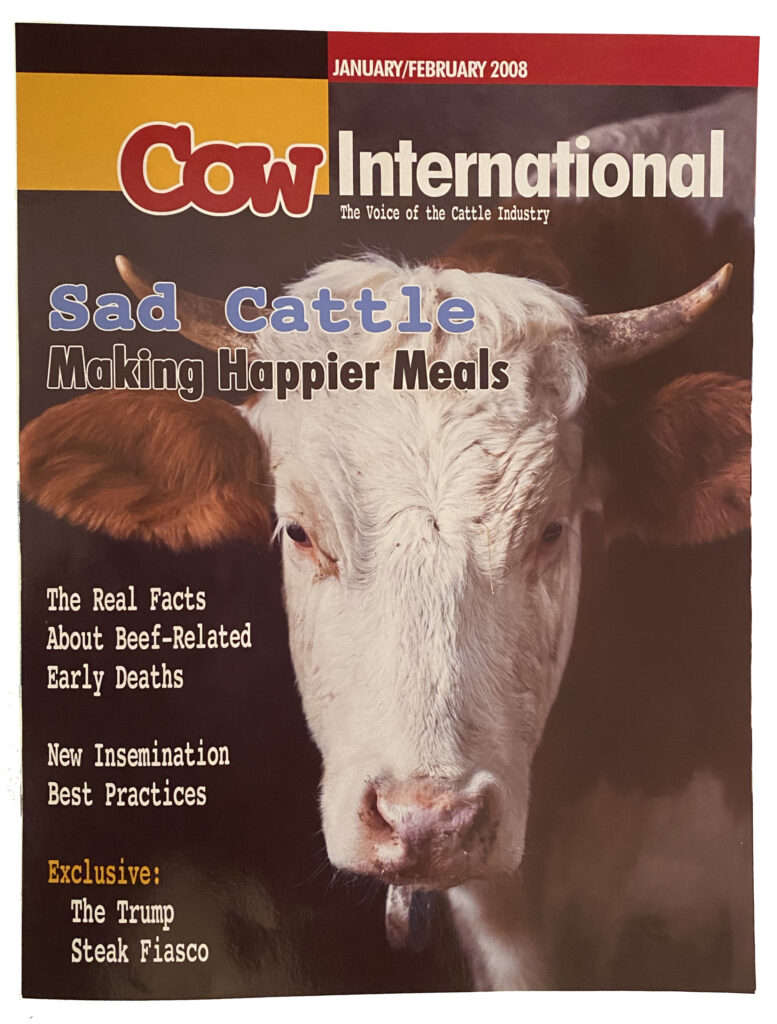
(From “The Great Trump Steak Disaster,” by Leo Slye, Lucy Wood Smith and George Hayes. Reprinted with permission.)
When New York City businessman Donald Trump announced his foray into self-branded steaks in May 2007, no one in Premium Beef predicted success. As one industry wag put it at the time, “This is a man who orders his steak burnt and then slathers it with ketchup. He might as well be eating horse hide.”
And so it was no surprise that despite Trump’s reality television celebrity and East Coast hucksterism, the launch was an unmitigated disaster. Available “exclusively” through a gadget catalogue and a cable shopping network, the reputed “World’s Greatest Steaks” sold less than $50,000 worth of its overpriced and subprime product before being discontinued two months later.
A six-month CI investigation has found that Trump’s failure was deeper and more profound than previously thought, involving poor inventory control, resulting in desperate attempts to repurpose suspect meat, and a wanton disregard for the norms of the beef industry.
The Steak Stakes
“When it comes to great steaks, I’ve just raised the stakes!” Trump crowed in a commercial introducing his new beef line in May 2007. “Trump Steaks are by far the best tasting, most flavorful beef you’ve ever had. Truly in a league of their own.”
For some reason Trump decided to forgo the traditional premium meat marketing – first to upscale restaurants and then in the high-end grocery space – and instead chose a mail order model, a curious choice for such a perishable product. His business partner was even more unusual: Sharper Image, the consumer electronics store more known for massage chairs than massaged meat.
“Believe me: I understand steaks,” Trump assured his potential customers.
He did not understand steaks.
Cover Story
The venture seemed doomed before it began. As part of the launch Sharper Image was to feature Trump and his steaks on the June cover of its magazine. Trump micromanaged every aspect of the production, multiple sources told CI. “He was a such a c***,” said one person who was at many of the cover shoots. “Lighting, he would just move the lights about, saying he knew more about lighting than any ‘photo guy’.” Trump insisted on his own hair and makeup, which took four hours and was attended by several technicians wearing lab coats, sources said.
CI has learned the cover had to be reshot several times because Trump was either dissatisfied with his hair or the model he had chosen to appear with him. Then on May 15, Trump called Sharper Image CEO Jerry Levin at 3 a.m. in an agitated state. He had shown the cover to his wife Melania and she felt it would be better without the model. When Levin explained that it was too late, the magazine was already on press, Trump reportedly screamed, “Lose the f*****g girl, OK?!”
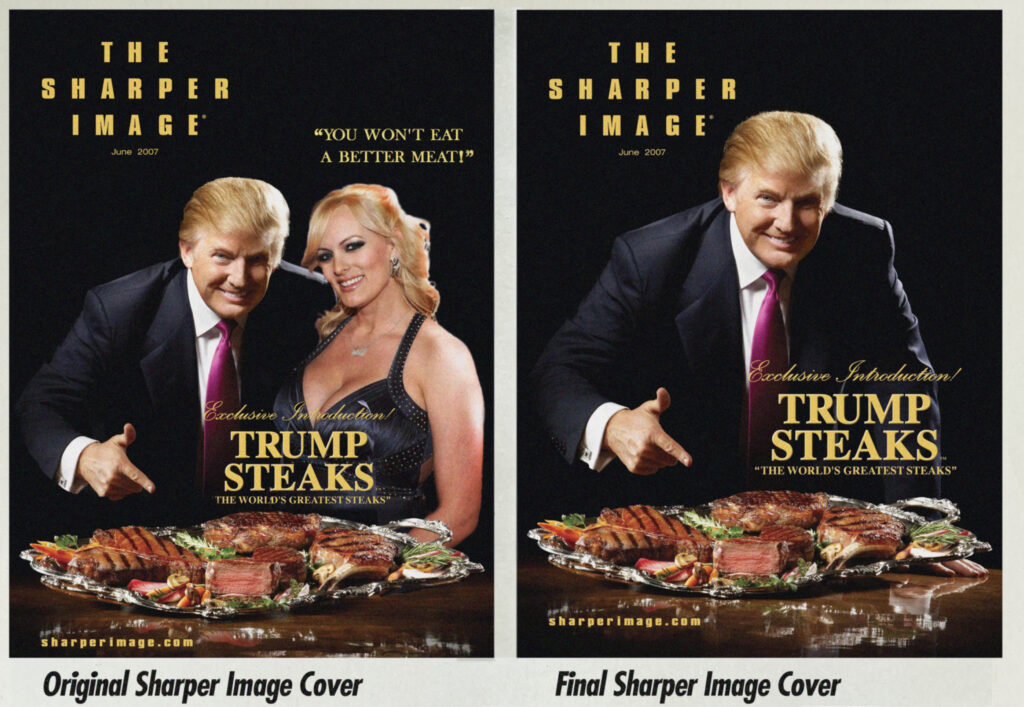
More than 28,000 copies had to be destroyed at an estimated cost of $40,000. Trump agreed it would be paid out of the profits.
Unfortunately, there were none.
Perhaps it was the price, ranging from $199 for the Classic Collection (two 6-ounce filet mignons, two 16-ounce cowboy bone-in rib eye steaks and 12 6-ounce sirloin burgers) to $999 for the Connoisseur Collection (four of each type of steak and 24 burgers.) That works out to about $50 a pound. Plus shipping, handling and applicable sales tax, of course.
Perhaps it was the taste. When Trump later went on QVC to hawk the product, he did manage to peddle some of his wears. However, the feedback was brutal, with a majority of one or two-star reviews, of which this was typical.

Other reviewers described the meat as “mealy,””grainy like liver,””bland,” “dry,” “loaded with fat and messy to clean up,” “greasy and tasteless,” “nothing but grease” and “Really greasy, have no flavor, overpriced, and just gross!!”
Or perhaps people who buy True Night Vision binoculars and Precious Moment figurines aren’t into pricey, greasy meat.
“The net of all that was we literally sold almost no steaks,” CEO Levin now says. “If we sold $50,000 of steaks grand total, I’d be surprised.”
Sharper Image pulled the steaks two months later. QVC soon followed.
If that had been the end of it, it would have only been another in a long line of failed Trump-branded products, along with Trump Airlines, Trump the Game, Trump magazine, Trump American Pale Ale, and most recently, Trump Vodka.
That was not the end of it.
Sauce or ?
Trump’s master plan was to sell a line of steak accessories, which would come with a license agreement requiring them to only be used with “Trump-branded steaks and steak derivatives.” Ultimately nothing came of proposals for Trump Golden Grills, Trump Charcoal Supreme, Trump’s Best Tasting Wood Chips and Trump’s So Sharp Steak Knives. CI has found evidence of only one original line extension to reach production, if that is the right word: Trump Steak Sauce.
The sauce was said to based on “an old Trump family recipe,” composed of “red ripe tomatoes, fine vinegars, syrup extracted from 100% American syrup, and a secret and legally protected mix of spices and chemicals.” Expecting massive sales, Trump Steak Sauce had an initial production run of 100,000 cases.
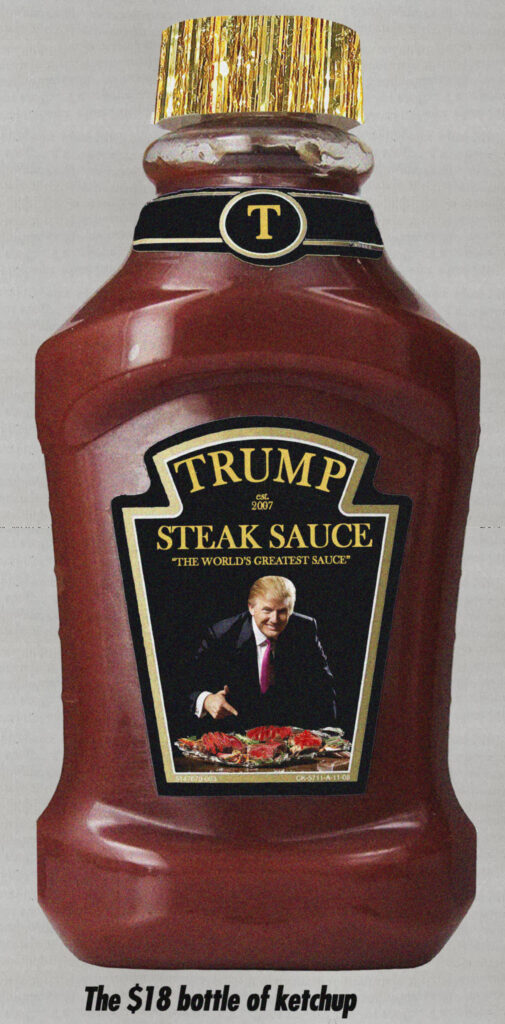
However, before the sauce could go on sale, Trump was warned by his lawyers, and the lawyers who replaced them, that he could not slap a label on top of bottles of Heinz Ketchup and charge $18 for it. Trump reportedly continues to keep these for his personal use, despite the fact that the condiment has begun to separate.
Something is Rotten
Anticipating unprecedented demand for his steaks, in April 2007 Trump ordered the slaughter of 6,200 head of Trump Cattle™, according to a participant who does not wish to be identified because he is ashamed. When the anticipated demand failed to materialize, Trump found himself sitting on 2.7 million pounds of freshly butchered meat.
He scrambled to recoup his losses.
According to three sources, Trump first attempted to offload his steaks to fine restaurants as “aged beef,” unaware that this is not simply meat that has been around for awhile. Then he offered the beef at a 50% discount to multiple chain restaurants, and was incensed when Black Angus, Outback, Chipotle, McDonald’s and even Taco Bell turned him down.
A Dog’s Breakfast
One evening in late July, Trump had a brainstorm when his driver hit a dog of some kind.
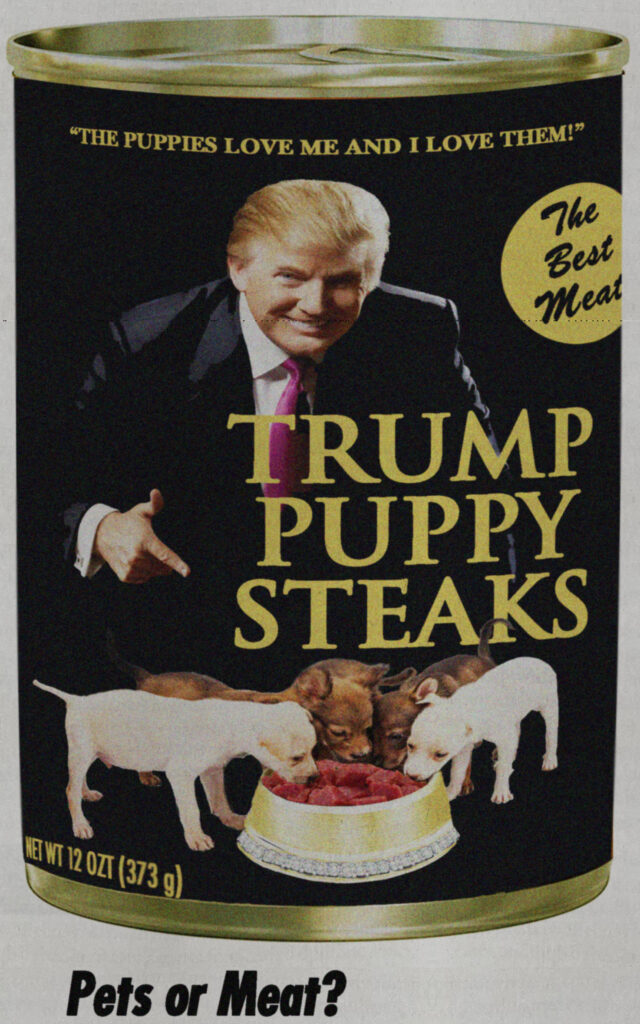
But in test markets consumers were confused as to whether the food was for or of puppies. In any case, they were unwilling to pay $50 for a can of dog food.
A few nights later, Trump was in his Trump Tower apartment, adjusting his assets for an urgently needed loan from Deutsche Bank, when he heard his infant son Barron crying in another room. An associate remembers him pointing to his head and saying, “Viola!”

According to an associate who was there, Trump “blew a gasket” when told that safety standards for baby food were even more stringent than they were for pet food, and vowed to eliminate such burdensome regulations “when the change comes.” On September 22, the U.S. Food and Drug Administration confiscated 8,000 cases of Trump’s Baby Meat as it was being loaded onto a freighter to China, an agency official confirmed.
Desperate Measures
From there, Trump’s attempts to salvage his investment became increasing ill-advised, according to documents supplied to CI.
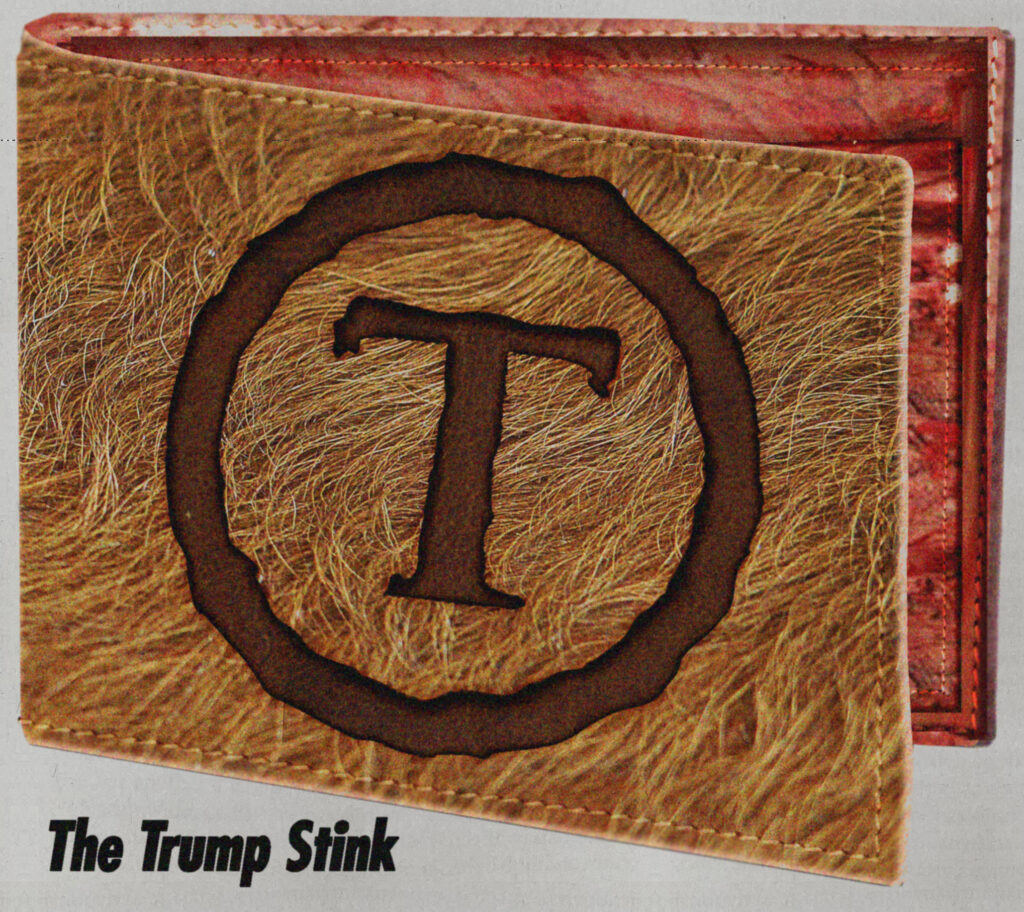
He hastily put out a line of TrumpBrand™ Wallets, forgoing the usual tanning and marketing them as “all-natural.” The wallets, however, soon began to stink, and Macy’s returned 61,500 of them. (Trump had kept 500 for employee Christmas bonuses.)
Some other products didn’t make it past the prototype stage before federal authorities intervened.
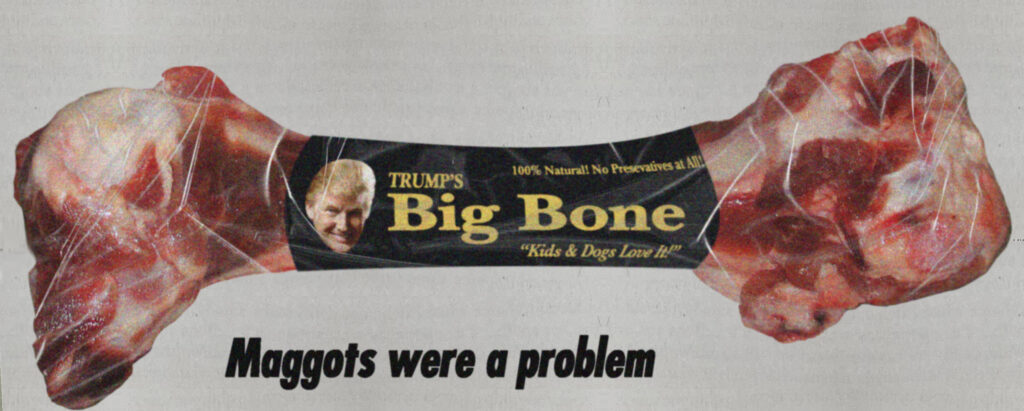
Trump’s Big Bone, untreated and uncooked cow bones incompletely enclosed in generic cling wrap, drew the attention of the USDA, the FDA and the CDC Division for Vector-Borne diseases (For reasons not fully understood the bones were found to contain the eggs and larva of Aedes aegypti, the mosquito responsible for dengue fever. )

The earliest samples of Ole MacTrump’s Half Jerky resulted in a heavily armed response from the FBI’s Joint Terrorism Task Force, after an undocumented Trump worker showed up at the hospital with both bovine spongiform encephalopathy and anthrax. (Before he died, the employee was fired for theft of company jerky.) Trump avoided bioterrorism charges only through the discovery of Illya Kuryakin, a Russian operative in his employ, who wrote a complete confession before committing suicide by smashing his head repeatedly into a glass coffee table.
A Happy Ending?
The ultimate cost of the Trump Steaks fiasco is difficult to estimate, in terms of both blood and treasure. In bankruptcy, Trump himself walked away with $6 million in nonrefundable licensing fees and $4 million as a meat consultant, while unpaid vendors incurred losses exceeding $23 million. Inside sources claim Trump was able to profit further, buying the remaining inventory for one dollar and then selling it to an unnamed Saudi prince. It is not known what ultimately happened to the more than a thousand tons of rancid meat and meat byproducts.
UPDATE: In 2012, the Trump Steakhouse in Las Vegas was shut down for 51 health code violations, including serving five-month-old duck.
* There is no such magazine. Nevertheless, much of this is true, though not necessarily the parts that make sense. Real quotes and factual details stolen from the New York Post, the New York Daily News, GQ, Rolling Stone, Think Progress, Death and Taxes and Wikipedia.
